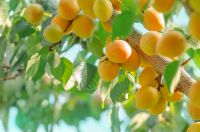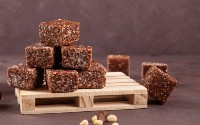June 2021 Edition
What’s New
The heart rate depends upon a number of factors including age and fitness levels. As a child grows older the rate falls. A new born baby’s heart beats from 70 to 100 beats per minute while that of an athlete can be 40 to 60 bpm mainly because the fitness makes the heart beat more efficiently and pump more blood in every beat.
Nature’s Remedy Just Beyond Your Front Door

Feeling sluggish? Unmotivated? Stressed? Depressed or anxious? Before you reach for medication, consider a remedy that exists just beyond your front door. Compelling scientific evidence shows the less time children and adults spend in nature, the greater the detriment to our well-being. Here’s a closer look at “nature-deficit disorder” and the health benefits of being out in the natural world.
Lack of Time in Nature is Killing Us Slowly
Evidence suggests that nature deficiency contributes to the following health issues:
- increased stress
- trouble maintaining focus/attention
- diminished emotional expression and resilience
- deficits in creative thinking and reasoning
- reduced capacity for forming healthy social relationships
- increased risk / worsening of chronic illness
- loss of connectedness to the natural world and one’s responsibility for it
Even though nature-deficit disorder is not yet regarded as a medical condition, both conventional and holistic health practitioners recognize the detrimental effects from lack of contact with nature as significant. These practitioners view nature-deficit as a nonclinical syndrome that can impair the emotional, cognitive, and physical functioning of adults and children.
Health Benefits Provided by Mother Nature
- reduced stress symptoms, blood pressure and heart rate
- improved cognitive functioning (focus, attention, problem solving)
- enhanced self-awareness and feelings of peace, relaxation
- reduced anxiety, depression, and cognitive dissonance
- enhanced self-esteem, personal and social relationships
- reduction in delinquent behavior among teens
- expansion of one’s sense of time, which can reduce stress and worry
Spending time in nature has tremendous health benefits and can reverse the effects of nature-deficiency by stimulating underused neuro-sensory pathways (the pathways to and from the sense organs and the brain/mind). Additionally, pathways that have been over-stimulated by use of technology are revitalized; we experience a refreshing change to our disconnected psyches, shifting from “urban-zombie” to being ecologically aware and re-connected to the natural world.
Even as our lives have changed during the COVID-19 pandemic, experts have urged us to get outside, in wide open spaces. This was not only for social distancing purposes. If you are still mostly indoors, experience the benefit of letting nature into your living space: Open windows to bring in fresh air. Sit near a window and meditate on the natural elements within your view. Grow potted plants indoors. Do whatever you can to enhance your wellbeing by immersing yourself in natural environments. Some benefits can be noticed immediately while others happen over time:
These findings come from studies that have looked at the effects of nature experiences such as wilderness therapy excursions, recreational hiking and camping, or simply spending time sitting in a park or garden.
Get Your Daily Dose of Nature
hether for 15 minutes or a few hours, here are a few ideas to help you experience the health benefits of nature:
Forest Bathing. It’s not a bath in a river. It’s not a hike with a destined path to follow. Forest bathing or shinrin-yoku, is a tradition that emerged in Japan during the 1980s. It’s a meditative immersion in the natural world where you slow down and intentionally turn your attention to the smells, textures, tastes, and sights of the forest.
Observe the Night Sky. Before going to bed in the evening, stand outside (away from artificial light) and gaze at the night sky. Shift your focal awareness to a single star, then to a cluster, then to the galaxy above you.
Take a Stroll. This is not a goal-oriented, step-counting walk. Just a stroll. If you can go for 20 or 30 minutes, great! If not, even 5 minutes is better than not going at all. As you walk, just breathe and observe. Let any worries slip away with each exhalation.
Sit Outside. When was the last time you saw your own backyard or front porch? Or the park a few blocks away from home or the office? Get there–without the phone–and just be present. Just observe.
Grow a Garden. If you don’t have the space at your own home, consider a community supported garden plot or volunteer to work at a local farm (sometimes in exchange for products they grow). Get your hands in the dirt, breathe in the smell of the earth, and release your worries.
Whether you go paddleboarding, draw, color or paint outside, take a plein-aire art class, join a nature conservancy group and help clean the trails, take an agility class with your pet, or go to the beach or lake/pond, the point is to get outside and get your dose of nature.
Food for Thought. . .
“The doctor of the future will give no medicine, but will instruct his patients in care of the human frame, in diet, and in the cause and prevention of disease.” – Thomas Edison
Apricots are Awesome!

Though some will argue the apricot’s place of origin–China, Persia, India, or Armenia–there’s no denying the worldwide appeal of the tangy flavor packed in this little fruit. Now widely grown in the Americas, apricots make a healthy and versatile food choice, great for cooking, as well as eating raw, sliced, baked and dried.
Apricots are a yellowish-orange fleshy fruit enclosed in an edible outer skin that is softly fuzzy. A serving size of 100 grams of fresh apricots provides you with several nutrients, most notably vitamin C, vitamin A, fiber, and potassium. Apricots are naturally high in antioxidants, which protect our cells against environmental damage from sunlight, pollution, and toxins such as cigarette smoke. Antioxidants, along with the beta-carotene in apricots, may benefit your skin by lowering your risk of wrinkles and sunburn.
To get the most from an apricot, eat them while in season (June-early Fall), choose organic when possible, and wash the fruit to remove debris from the skin. When picking apricots, the skin should be uniform in texture, free from damage spots or cracks and not too hard or soft. You should be able to cut or bite into the fruit with ease.
Cooked or raw, apricots add a delicate tang to rice dishes, salads, fruit parfaits, and baked goods. They are an ideal snack to take along on a day spent outdoors. Dried apricots are a wonderful addition to granola, oatmeal, and fruit and nut mixes…plus, you can enjoy the dried fruit all year long. Ideally, look for dried apricots that are sulfite-free and sugar-free.
Apricot-Date No Bake Trail Bars

June is the perfect time to experiment with the tangy sweetness of apricots. These snack bars are good fuel for wherever life takes you. Pack them for your next excursion in the great outdoors or as a healthy, sweet treat for a family picnic. You’ll love them so much, we bet you’ll start packing them for snacking during long days at work, too!
Ingredients
- 1 cup dates pitted and chopped
- 1 cup dried apricots, chopped
- 2 Tablespoons chia seeds
- 1/4 teaspoon cinnamon
- 1/4 teaspoon ginger powder
- 1 cup raw pumpkin seeds/pepitas
- 2 Tablespoons carob chips (optional)
Preparation
- Line a 8×8 or 9×9 square pan with parchment paper.
- Food process dates, apricots, chia seeds, cinnamon and ginger until a large mass forms.
- Add pumpkin seeds and pulse until the seeds are broken up into pieces.
- Add carob chips and pulse a few times to break up and distribute the chips.
- Press the mixture into the pan.
- Refrigerate for 30-45 minutes, then slice into bars or squares.
Minimize Outdoor Allergy Symptoms with Stinging Nettle

If you love to be outdoors, but are irritated by seasonal pollen, consider the herb Stinging Nettle to help reduce the sneezing and itching symptoms of hay fever. A well-established remedy in Western botanical medicine, Stinging Nettle (Urtica dioica) leaves are recognized for their anti-inflammatory properties and other actions that support the immune system’s response to allergens.
Stinging Nettle does a good job at stabilizing mast cells, a type of white blood cell that becomes overactive in the body’s response to allergens and other substances that can enter the body. The leaves have been used to alleviate irritation seen in allergic respiratory symptoms as well as skin allergies. Stinging Nettle has a diuretic effect, which can help flush environmental irritants out of the body. It also supports the detoxifying action of the lymphatic system, which has important roles in immunity and recovery from illness or injury. Even though it has diuretic actions, which can flush nutrients along with toxins from the body, Stinging Nettle is also nourishing because of the robust nutrients it contains. This is why it’s considered to be a “balancing” herb.
One of the best ways to alleviate allergy symptoms is to drink a cup of warm Stinging Nettle tea a few times throughout the day: Steep 2 tablespoons crushed dried leaves in 12 ounces of water. Combine with 1 teaspoon local honey. If you are heading outdoors on a summer day, chill the tea the night before and bring it with you. When not combined with other herbs, nettle tea has a flavor profile similar to green tea: grassy with earthy notes.
Avoid Stinging Nettle if you’re allergic or sensitive to nettle or plants in the same family. There is evidence that this herb can lower blood pressure, change blood sugar and cause uterine contractions. If you take high blood pressure meds, have diabetes or are pregnant, check with your doctor before using Stinging Nettle on a regular basis.
Allergen Fighting Nettle Tea Blend
This is a great recipe for chilled stinging nettle tea that adults and kids can enjoy. This combination of herbs shifts the flavor profile from grassy to earthy/flowery.
Ingredients
- 1 ounce rooibos tea leaves
- 1 ounce nettle tea leaves
- 1 ounce lemon balm tea leaves
- 1/2 teaspoon ground ginger (or grated fresh ginger)
Preparation
- Mix tea leaves together in an appropriate size airtight container (you will store the extra tea)
- Use about 1 heaping teaspoon of tea per 8 ounces hot water*
- Let steep, covered, for 5 minutes, then add raw local honey and/or fresh lemon, if desired.
- Store in the fridge overnight, or add plenty of ice and head outdoors. Sip frequently.
*Make sure water doesn’t exceed 212 degrees F, which is the boiling point at sea level; otherwise it can lessen the effectiveness of the tea.
Options: You can add other herbs in equal amounts to the blend. For example, lavender or peppermint could replace lemon balm. Experiment, but keep your total variety of teas to five or fewer.
Selecting a Quality Multivitamin or Mineral Supplement for Kids

Nutrition power is every kid’s best defense against illness and the guideline for raising healthy kids requires providing them with a daily diet of a variety of healthy foods. But we all know that’s easier said than done. Kids are confronted by the temptation of packaged foods that typically are not part of a balanced diet. Some kids are picky eaters who just won’t bite at the wholesome foods their growing bodies need. And, truth be told, there are days when parents lose the edges of their life and have a hard time putting those healthy meals on the table. This is why a multivitamin and mineral supplement can be beneficial in supporting your child’s health.
Even if kids choose fresh foods over packaged most of the time, we have to remember that today’s food system is stressed by environmental factors such as natural disasters and use of chemicals. These environmental stressors lower the quality of the nutrients food should contain. This can lead to a deficit of essential dietary nutrients, which can lead to health issues.
Selection Considerations for Kids’ Multivitamin or Mineral
One look at the packed shelves in any pharmacy or grocery store shows you why it is so important to know what you are buying. The best way to acquire a supplement that has been properly formulated and addresses a child’s individual needs is to consult with a holistic practitioner who is trained in pediatric/adolescent nutrition.
If you do make the selection on your own, look for the following symbol on the product packaging and consider the tips that follow in your selection criteria.
If you do make the selection on your own, look for the following symbol on the product packaging and consider the tips that follow in your selection criteria.
Check labels to be sure the product is free from fillers, toxins, and added sugar. Products that feature cartoon characters are fun to look at, but upon closer inspection you’ll see they may lack the quality features that impact bioavailability.
Careful with the Gummies. The gummy variety of any supplement can contain refined sugars. Also, gummies can inadvertently send the wrong message to younger kids that vitamins are candy. If you must go with the gummies, look for one sweetened with natural fruit flavors.
Careful with the Gummies. The gummy variety of any supplement can contain refined sugars, but Dr. Samm’s Gummies don’t. Also, gummies can inadvertently send the wrong message to younger kids that vitamins are candy unless you are very clear that they are vitamins. If you must go with the gummies, look for ones sweetened with natural fruit flavors and have no artifical flavors like the ones that Dr. Samm has.
Other selection criteria that may be of importance to you include GMO-free, organic certified, whole-food based, vegetarian or vegan friendly, allergen-free, and cruelty-free. These should be clearly marked on the label. You likely won’t find all of them in a single product, so prioritize what is important to you. If you are unsure, speak to a holistic practitioner who can make recommendations suited to your child’s individual needs.
Get Creative with Circuit Training at Home or Outdoors

Whether you’ve been working out in a home gym or have been able to go back to a local fitness center, it’s inevitable that, at some point, you’ll get bored with your exercise routine. This is where circuit training comes in, inspiring creativity in your routine and putting the mojo back in your motivation.
Circuit Training incorporates a set number of stations of exercises targeting all the major muscle groups in one workout. A typical circuit takes 30-45 minutes to complete. However, more seasoned exercisers can intensify their workout with advanced movements for a shorter time of 20-30 minutes. In a gym setting, traditional circuit training involves the use of body weight only movements, machines, and free weights. The exercises are performed in sequence for 1-3 rounds with a specific amount of rest between each round. At each exercise station, 12-15 reps would be completed. Today, exercise stations include more variety of exercises and can include balls, bands, and suspension training stations. Additionally, the number of reps, total number of stations, and rest-work periods can be varied for different workout goals, such as enhancing muscle endurance or cardiovascular fitness.

If you’re ready to get out of the home gym or fitness center and enjoy circuit training, try these routines:
Drill Sergeant’s Circuit incorporates mostly body weight exercise stations. If you have a fitness trail near you, this is a great place for this workout. It includes: pushups, dips, sit-ups, pull-ups using different hand grips, squats with or without a medicine ball, plyometric jump squats, sprints, bear crawls and any other movement from a boot camp protocol. To up the challenge, wear a weighted vest during the workout.
Team Sports Circuit incorporates exercises based on sports movements such as soccer, football, basketball, volleyball, and baseball. Here you might have kicking drills using a ball and a target, sprints, lateral scooting style moves, full-body thrusts against a padded sled or sled pushes/pulls, jumping, shooting, and twisting moves or drills. Whatever the move or drill, it mimics, or is related to, the conditioning of a move from a sport.
On the Ball Circuit involves the use of various size therapy balls, possibly light hand-held weights, and medicine balls. Included squats, crunches, leg lifts, and a wide variety of movements using different balls.
Hit The Trail Circuit is done outdoors where you can run, walk, sprint, side shuffle, and use the elements of nature around you (tree limbs, branches, inclines and declines) to squat, jump, and swing your way into shape.






